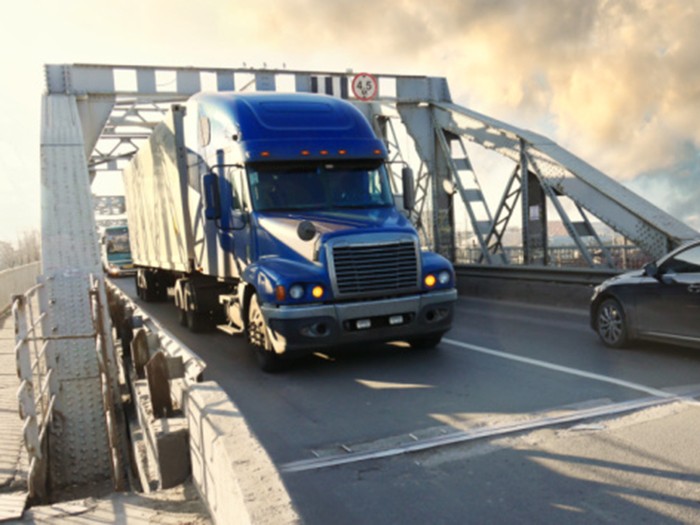Supply Chain Risks
Deficient Bridges Could Mean Supply Chain Woes

In its 2015 report on the nation’s bridges, the American Road & Transportation Builders Association (ARTBA) labeled 58,500 U.S. bridges — roughly 10 percent — as structurally deficient.
Nearly half of those — 27,486 — have some sort of load restriction. While a slight improvement over 2014, the issue still represents potentially serious supply chain risks for many businesses, and the problem will not be going away any time soon.
“The good news is that we’re definitely seeing a reduction in the number of structurally deficient bridges out there,” said Alison Black, ARTBA senior vice president, chief economist and author of the report. “[But] at this pace, it will be over 20 years before we solve this issue.”
Between 2014 and 2015, 7,200 structurally deficient bridges were removed from the list, but those repairs and replacements, while representing long-term progress, can mean even more acute restrictions or outright closures in the short term.
And meanwhile, another 4,625 bridges were added to the list.
Supply chain interruptions from bridge restrictions can affect a wide variety of businesses.
“Things that have to be refrigerated, such as dairy, those kinds of industries, [or] retailers that might have a large distribution facility where you have a lot of concentrated economic activity in a very narrow space, those may be the businesses more likely to be affected,” said Vince Morgan, a partner in the law firm of Pillsbury Winthrop Shaw Pittman LLP who specializes in insurance law and risk management.
Clark Schweers, the leader of BDO’s Forensic Insurance and Recovery practice, added that specialty manufacturers who use volatile chemical compounds that require special care could also be impacted.
“It really impacts all industries in one way or another,” he said.

Clark Schweers, BDO’s Forensic Insurance and Recovery practice leader
Bridge restrictions can also force trucking companies to reduce load sizes.
“It may be that you used to get two truck deliveries a week of a particular commodity … and now, because of weight restrictions, you have to get four trucks that each have lower weight loads. That adds to your expense and can disrupt your supply chain system,” Morgan said.
Closures or restrictions can also interrupt business by impeding customer access.
The ARTBA report does not include the nation’s 77,000 railroad bridges. According to Black, a 2007 GAO report said there is “little information publicly available on the condition of railroad bridges and tunnels.”
While road bridge workarounds can cause delays and increase business costs, Schweers pointed out that railroad bridges are often “a single source supplying multiple facilities that are reliant on those railroads,” making workarounds more elusive and supply-chain interruptions more problematic.
According to Schweers, traditional supply chain studies do look at transportation logistics, “but there probably has not been enough focus on the transportation infrastructure.”
“It starts with your business continuity plan and building a resiliency around that,” said Morgan.
“If there is a vulnerability from a transportation standpoint then you need to identify it and look at avenues to mitigate it before it becomes a real problem.”
Businesses can check with their state departments of transportation for information about transportation restrictions that could impact them.
“The information is based on bridge inspection reports, which happen every two years, so definitely checking in with the state DOT is the best way to get information about specific bridges,” Black said.
Schweers and Morgan advised businesses to check for gaps in their coverage. A single word or syllable can mean the difference between a loss that is covered or not.
According to Schweers, “the ingress/egress area, whether you have the word ‘prohibit’ or the word ‘inhibit,’ that one word right there can have a vastly different scope or meaning in terms of potential recovery within your insurance policy.”
Policies covering ingress or egress that is prohibited but not inhibited would cover losses from bridge closures, but not losses from weight or other restrictions.
“If you’ve got impairment language in the ingress/egress or civil authority provisions of your policy, that is going to trigger coverage,” said Morgan. “If you have prohibition language, you might have a harder hill to climb to get a covered loss.”
Morgan said there are rare instances of policies manuscripted to exclude specific bridges.
“It tends to be a specific case where a business is very dependent on a particular bridge and [the insurer] may have questions about the soundness of it,” he said. “But those are the kinds of things you need to look at in your policy and find out before it rises to an actual problem for you.”
Schweers agreed. “Having those discussions with your carriers and with your brokers outside of an actual loss is really a best practice and something that we would recommend for all parties, to sit down and explain the risks to the business and try to determine whether or not the policy would be triggered in a given situation.”












